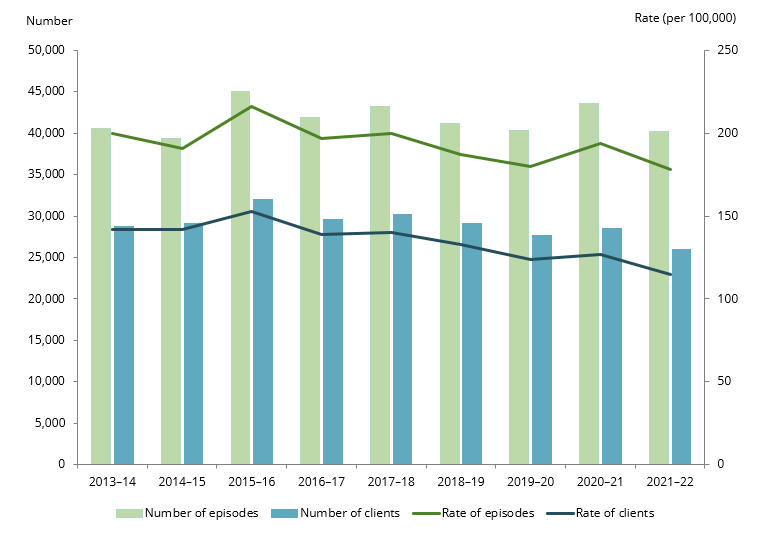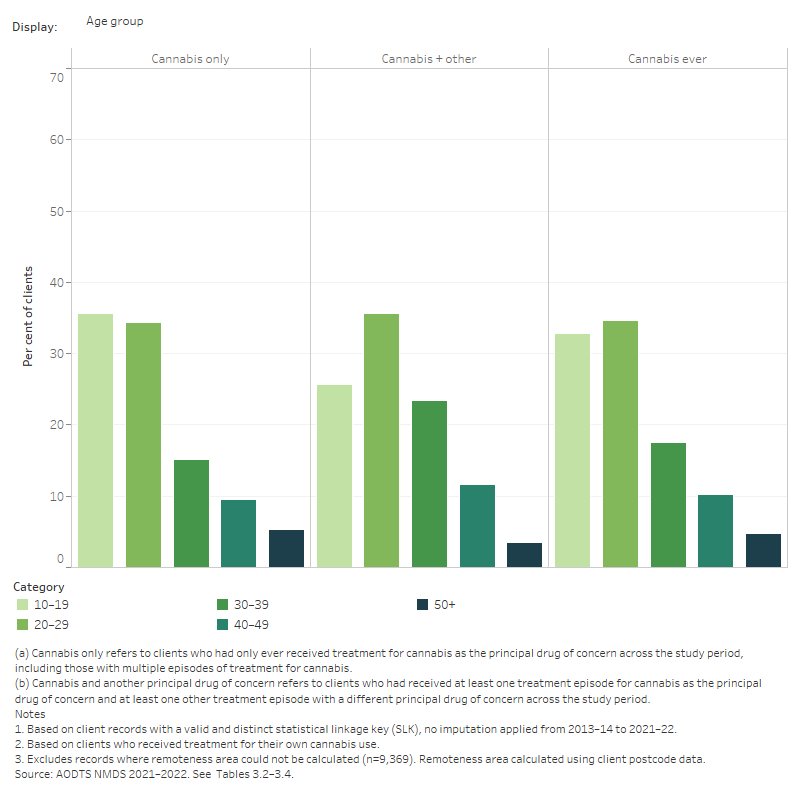Cannabis treatment
This section uses data from the Alcohol and Other Drug Treatment National Minimum Data Set (AODTS NMDS) to describe the characteristics of people who received treatment for cannabis use between 2013–14 and 2021–22. The AODTS NMDS contains information about treatment provided to clients by publicly funded specialist alcohol and other drug (AOD) treatment services across Australia. It has been reported annually since 2003–04, with collection periods beginning on 1 July and ending on 30 June of the following year (that is, financial years). It includes data on the number of closed treatment episodes (that is, episodes of care) provided to clients and the number of clients who received treatment in a collection period (that is, financial year), noting that the same client may receive multiple treatment episodes within or across collection periods. In 2012–13, a statistical linkage key (SLK) was introduced to enable counting of the number of individual clients receiving treatment across collection periods. Clients receiving treatment for another person’s AOD use were excluded from this report. For more information, see Technical notes.
Annual clients who received treatment for cannabis, 2013–14 to 2021–22
Data from the annual reporting cycle of the AODTS NMDS indicate that cannabis is the third most common principal drug of concern among treatment episodes provided to clients for their own drug use, accounting for 19% of episodes in 2021–22 (AIHW 2023). This represents a rate of 115 clients and 178 episodes per 100,000 population, down from a peak of 153 clients and 216 episodes per 100,000 in 2015–16 (Figure 9; Table 3.1).
Figure 9: Annual number and rate of clients and treatment episodes, where cannabis was a principal drug of concern, 2013–14 to 2021–22

Source: AODTS NMDS 2021–22. See Table 3.1.
Notes
- Based on client records with a valid and statistical linkage key (SLK).
- The crude rate is based on the preliminary Australian estimated resident population as at 31 December of the preceding year based on the 2021 Census. Rates may differ from previously published data based on revised Australian population estimates.
- Based on clients who received treatment for their own cannabis use.
Longitudinal client cohort who received treatment for cannabis, 2013–14 to 2021–22
The remainder of this section uses data from the AODTS NMDS to describe the characteristics of clients who received treatment for cannabis as a principal drug of concern (PDOC) and their pathways through alcohol and other drug (AOD) treatment. Clients can only receive treatment for one PDOC per treatment episode, but clients may also receive multiple treatment episodes for different principal drugs of concern. In this report, the criteria include information about a cohort of clients who received at least one closed treatment episode in at least one collection period between 2013–14 and 2021–22 where cannabis was the PDOC. This cohort includes:
- ‘Cannabis only’, which refers to clients who only received treatment for cannabis (that is, one or more treatment episodes for cannabis and no treatment episodes for another principal drug of concern).
- ‘Cannabis and another PDOC’, which refers to clients who received treatment for cannabis and another principal drug of concern (that is, clients who received at least one treatment episode for cannabis and at least one treatment episode for another PDOC, such as alcohol).
Client counts are reported for both cohorts and combined as ‘clients who ever received treatment for cannabis’ (that is, the total cohort). Information about treatment episodes provided to these clients is also included. In the sections below, the period 2013–14 and 2021–22 is referred to as the ’study period’. See Technical notes for more information.
A total of 221,186 clients received treatment for cannabis between 2013–14 and 2021–22 (that is, the study period) (Table 2). Over 2 in 3 clients (71%) received treatment for cannabis only, while the remainder (29%) also received treatment episodes for a different principal drug of concern. Together, these clients received a total of 604,748 treatment episodes across the period. Around 2 in 3 (67%) treatment episodes for the total cohort were provided to clients receiving treatment for cannabis and another PDOC (Table 2).
Clients N | Clients % | Treatment episodes N | Treatment episodes % | |
|---|---|---|---|---|
Cannabis only | 156,253 | 71% | 225,732 | 37% |
Cannabis and ≥1 other principal drug of concern | 64,933 | 29% | 379,016 | 63% |
Total | 221,186 | 100% | 604,748 | 100% |
Source: AODTS NMDS 2021–22.
Notes
- Based on clients who received treatment for their own cannabis use in at least one treatment episode in at least one collection period (that is, financial year) between 2013–14 and 2021–22.
- Treatment episode data includes episodes for a principal drug of concern other than cannabis provided to clients who had ever received treatment for cannabis (for example, clients who had received treatment for both cannabis and alcohol across separate episodes would have both episodes counted in these data).
Client characteristics
Clients who had only received treatment for cannabis were more likely to be aged 10–19 than those who received treatment for cannabis and another PDOC (36% compared with 26%) (Figure 10, Table 3.2–3.4). Distributions for sex and remoteness area were similar across both cohorts of clients who had ever received treatment for cannabis.
Figure 10: Clients who had ever received treatment for cannabis, by cohort and age group, sex, and remoteness, 2013–14 to 2021–22
This figure shows the proportion of clients who had ever received treatment for cannabis between 2013-14 and 2021-22, by cohort ("Cannabis only", "Cannabis + other", and "Cannabis ever"). A filter is available to display the data by age group, sex, or remoteness area.

Treatment episode characteristics
Of all treatment episodes provided to clients who had ever received treatment for cannabis between 2013–14 and 2021–22:
- Diversion was the most common source of referral for clients who only received treatment for cannabis (39% of treatment episodes), while self/family was the most common referral source among those who received treatment for cannabis and another PDOC (36% of episodes).
- Counselling was the most common treatment type for both cohorts (43% and 35% of episodes for clients who only received treatment for cannabis and those who received treatment for cannabis and another PDOC, respectively).
- Most episodes ended with an expected/planned completion for both cohorts, but this proportion was higher for clients who only received treatment for cannabis than those who received treatment for another PDOC (73% and 59%, respectively).
- Among clients who received treatment for cannabis and another PDOC, the most common PDOCs were cannabis (38% of episodes), amphetamines (27%), and alcohol (20%) (Table 3.5).
AIHW (Australian Institute of Health and Welfare) (2023) Alcohol and other drug treatment services in Australia annual report, AIHW, Australian Government, accessed 1 March 2024.


